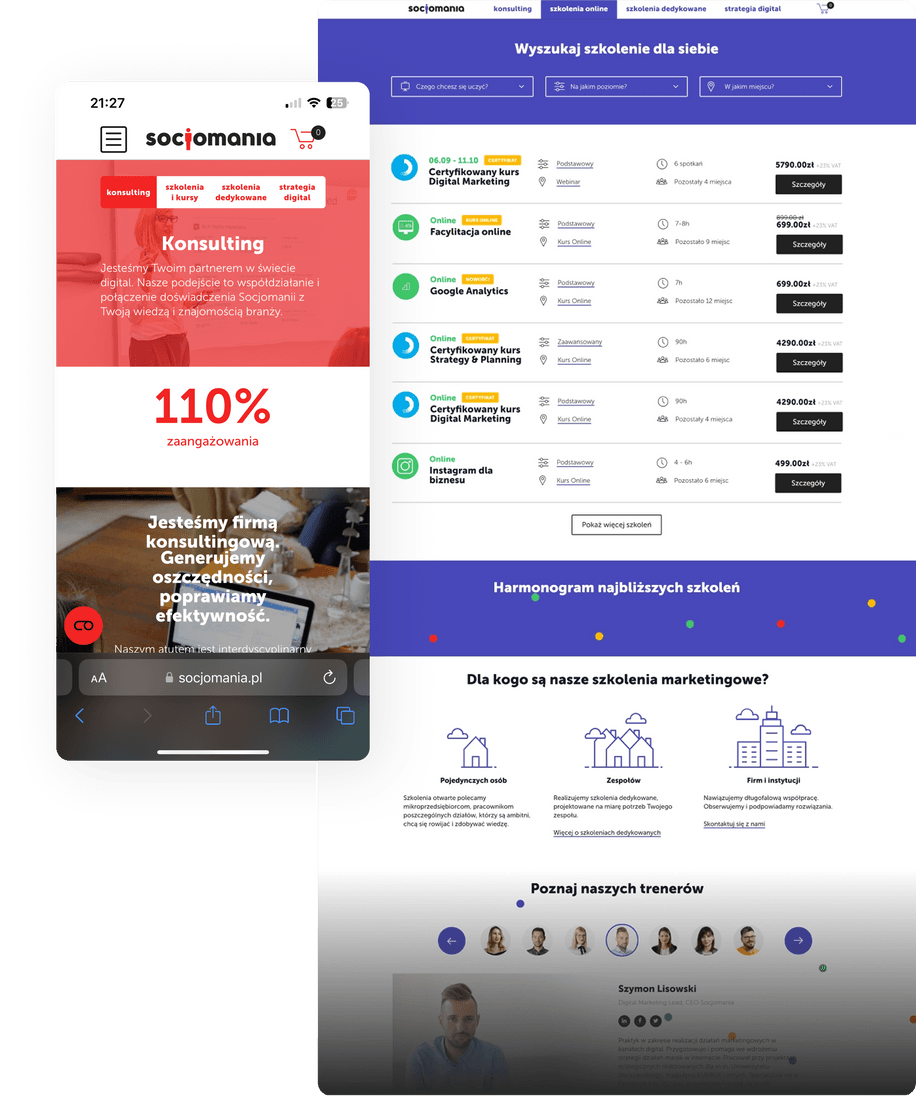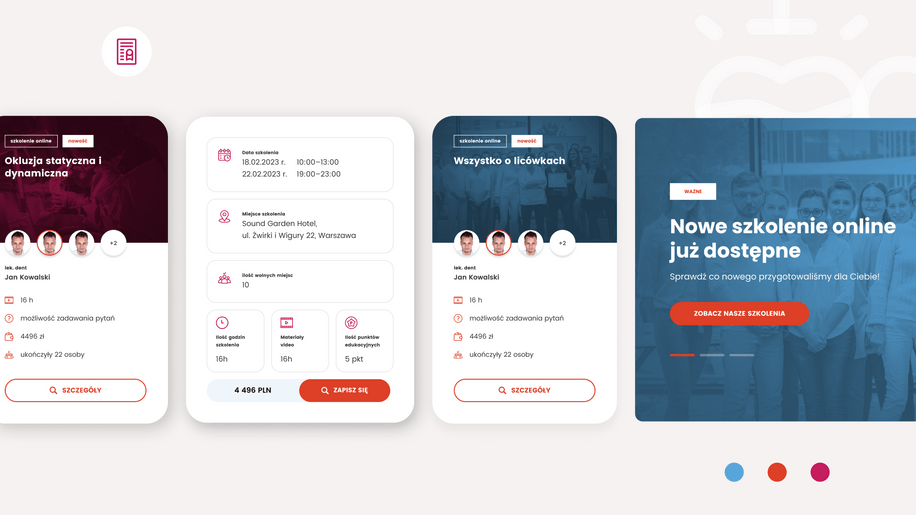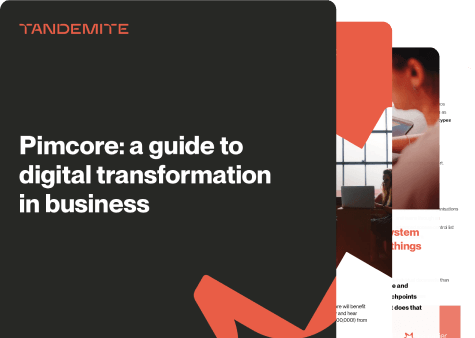Is Pimcore the ultimate tool for training brands? These 3 case studies say ‘Yes’ (Taxpress, Dental Day & Socjomania)

Digitally-savvy learners today want simple sign-ups, personal dashboards, quick access to resources, and open lines of communication with their instructors. If your site is still just a brochure, and bookings are done manually, you’re missing out on revenue, insights, and loyalty.
Three very different training brands – Dental Day (hands-on dentistry workshops), Socjomania (digital-marketing academy), and Taxpress (tax law publisher-turned-course hub) – all adopted the open-source Pimcore to centralize course offerings.
What’s the takeaway? Digital transformation in training is a must-have if you want to scale your efforts effectively and align with learner expectations. By reducing manual processes and improving productivity, it proves to be a smart investment – which is why Forbes calls it a “cost-saver, not a cost center.” In addition, having a digital presence helps establish trust, generate more leads, improve conversion rates, boost visibility across multiple channels, and gain insights through data analytics.
The reality check: Training firms have unique digital problems
Pain point #1: Fragmented stack
What it looks like day-to-day: WordPress for marketing pages, Typeform for feedback, Google Sheets for attendee lists, etc.
Why it’s inefficient: Data silos force staff to copy-paste names, resend confirmations, and reconcile payments by hand. Human error climbs; GDPR risk rises.
Pain point #2: Content-governance gaps
What it looks like day-to-day: Freelance trainers email Word docs to web admins; updates go live days later, sometimes with outdated regulations.
Why it’s inefficient: Learners see mismatched dates or prices, hurting credibility and SEO. Legal teams worry about publishing inaccurate guidance.
Pain point #3: No single customer view
What it looks like day-to-day: Data lives in payment gateways or email tools (transaction data sits in Stripe, attendance is in Zoom, progress is in Moodle, email opens in Mailchimp).
Why it’s inefficient: Sales can’t see which past attendee is ready for an advanced course; marketing can’t segment by skill level. Personalization becomes impossible.
Pain point #4: Scalability anxiety
What it looks like day-to-day: Each new course type, language, or city spawns extra plug-ins, custom fields, and spreadsheets.
Why it’s inefficient: Release cycles slow to a crawl; every change threatens to break half the stack (“plugin fatigue”).
Pain point #5: Mobile-first expectations
What it looks like day-to-day: 60 %+ of visitors open a course link on a phone, yet PDF schedules and wide tables break on small screens.
Why it’s inefficient: Friction at the top of the funnel kills conversions; users bounce to a competitor whose checkout works on the train ride home.
Pain point #6: Manual compliance overhead
What it looks like day-to-day: Grants or B2B clients demand invoice sequences, attendance certificates, grant codes, and signing sheets.
Why it’s inefficient: Staff spend hours generating PDFs and chasing signatures; mistakes trigger costly refunds or audit findings.
Pain point #7: Limited merchandising
What it looks like day-to-day: A course page is a PDF syllabus and a “Contact us” button. No cross-sell, up-sell, bundles, or volume pricing.
Why it’s inefficient: You work hard to attract traffic, then leave revenue on the table because visitors can’t add a coaching session or e-book to the cart in one click.
Integrations that matter for training providers
| System | Typical goal |
|---|---|
| LMS (Moodle, LearnDash, Pathwright) | Pass enrolments & completion status |
| CRM (HubSpot, Pipedrive) | Track lead → sale → renewal |
| Accounting (Fakturownia, Xero) | Automatic invoicing, tax compliance |
| Payment gateways (Paynow, Stripe) | Instant confirmation, refunds |
| Grant platforms | Validate learner eligibility |
Lessons from Taxpress, Dental Day & Socjomania (three different trainers, one flexible engine)

1. Taxpress
(Tax-law education portal, selling books, magazine subscriptions, and private workshops in one cart)
Need/Challenge: Three product types, legacy branding, SEO-heavy content model.
Feature: Pimcore lets editors tag products, bundle variants, link articles to relevant courses, and auto-generate a personal “virtual library.”
Benefit: Unified catalog, one source for courses, ebooks, webinars. It also supported rapid pivot to online courses during COVID-19.

2. Socjomania
(Marketing academy on “widgets”)
Need/Challenge: Complex discount rules, frequent content edits, and rapid landing-page creation by non-tech staff.
Feature: WYSIWYG editing and drag-and-drop widgets mirroring the final layout. Pimcore’s “basket rules” for package discounts.
Benefit: The system allows for self-service editing – the visual editor puts marketing back in control and cuts page-update time to minutes. Invoices fire straight into the accounting system.

3. Dental Day
(Specialized dentistry workshops with grant funding)
Need/Challenge: Renewing and bringing a modern touch to the website without alienating the brand’s loyal audience.
Feature: Course finder filters by topic, location, and lecturer. Integration with Paynow for payments, Pathwright for learning delivery, and Fakturownia for invoicing. Support for grant-based payments and wait-lists.
Benefit: 30+ automated notification types plus integrations slashed reservation processing. Dental Day ties each dentistry workshop to wait-lists. All orchestrated inside Pimcore.
How learning businesses profit with Pimcore
| Question on the table | Typical fix | Pimcore way | Why it matters |
|---|---|---|---|
| Can I push real-time updates (room changes, new slots) without devs? | Slack ping to IT, manual HTML tweak, or yet another scheduling widget | In-place WYSIWYG editing and structured data objects; changes propagate instantly via API to web, email, mobile | Last-minute room change? Students know instantly Learners get timely info, cancellations drop. Support inbox shrinks |
| Will I outgrow the stack in two-three years? | “Re-platform” once you need PIM, DAM, or multistore | Add a module → migrate nothing Pimcore bundles CMS/DXP, DAM, PIM, e-commerce, and customer data platform in a single open-source core. You can start with content and add commerce, personalization, or learning modules when the business is ready | Future-proofing saves budget and nerves |
| Can I manage courses, books and events side-by-side? | Multiple plugins or external stores, each with its own data model | One data object schema & taxonomy – courses, publications, vouchers share attributes | Central catalogue, less duplication, one admin panel, faster onboarding |
| How deep can I integrate with CRM / ERP / LMS? | Depends on plugin authors or vendor’s roadmap | Native REST & GraphQL APIs + Symfony under the hood | You stay in control of data flows |
| Can we handle bulk B2B and purchase orders, not just card payments? | Separate B2B portal or email + invoice workflow | Multiple checkout types: purchase order numbers, invoice terms, tiered pricing, grouped enrolments – all in the same cart Pimcore’s customer-specific pricing and REST endpoints fit neatly into ERP workflows | Corporate clients self-serve (they often enroll 30 learners, need split invoices, and progress exports) The finance team avoids manual spreadsheets |
| Is security & compliance (GDPR, SSO, audit logs) covered? | Mix of plugins and manual policies; limited logging | Open-source does not mean insecure. Pimcore supports fine-grained permissions, versioning, audit logs and GDPR tools for consent & data-erasure workflows | Lowers legal risk and shortens procurement checklists |
| How do we store accreditation evidence (tests, attendance, certificates) long-term? | Folder on a file server or third-party LMS exports | Pimcore DAM stores certificates, scans, sign-in sheets; metadata links back to learner profile and course instance | Compliance proofs live where admins can actually find them during audits (some regulators require storing attendance logs and assessment artefacts for X years) |
| Will our SEO suffer if we move? | Risk of URL changes, schema gaps, plugin conflicts | Clean URL management, built-in schema markup, redirects, and multilingual handling; metadata editing in the same UI | Rankings stay intact, organic leads keep flowing while you re-platform |
| We sell across borders with messy VAT rules – can the stack keep up? | Custom code in eCommerce store or rely on payment-gateway logic | Pimcore’s rule-based pricing engine with location and customer-group decorators; central tax classes mapped to ERP | Smoother audits, accurate taxation, fewer finance exceptions |
What this means for a training business
- Lower ops load: fewer tools, fewer handoffs, fewer errors.
- Faster change: marketing ships pages and updates without tickets.
- Better revenue mix: bundles, add-ons, and corporate orders in one flow.
- Compliance comfort: auditable, centralized evidence and GDPR controls.
- Future-proofing: add product types, locales, and channels without starting over.

Pimcore is trusted by more than 118,000 organizations (from retail to education) for its comprehensive digital experience platform. It holds a 4.4/5 rating on G2, with users praising its “all-in-one” flexibility. Still, many acknowledge that the setup process can be complex, which is why partnering with experts like Tandemite can be key to a successful implementation.
Decision-maker checklist
- Do we own our course, customer and payment data today?
- Could marketing launch a new workshop page without developer help?
- How many tools do we stitch together for one learner journey?
- What’s the cost of adding a new language or location?
- Can we personalize offers based on past attendance?
- Are compliance needs (invoicing, grants, GDPR) fully automated?
If multiple answers trigger hesitation or uncertainty, it’s a clear signal that looking into a unified stack could offer valuable improvements.
Next steps to take to digitalize your training firm
- Map your current stack – List every spreadsheet, plugin and manual workaround.
- Prioritise pain points – Which three processes burn the most time or cause learner frustration?
- Book a discovery call – Tandemite offers a free session to scope potential quick wins.
- Request a live demo – See the back office from an editor’s perspective, not just a slide deck.
- Calculate ROI – Use your seat volume, average price, and admin salary data to model payback.
- Start small – Pilot a single product line; expand once KPIs move in the right direction.
In training, digital transformation isn’t a sweeping rebrand. It’s a precise process of removing friction and inefficiency. Pimcore supplies the digital capabilities; Tandemite ensures the shift is stable, safe, and expertly managed. Together, we let your team focus on scaling up powerful learning experiences that drive results.
Digital tools help training businesses – large, small and highly specialised – grow and work smarter. Drop us a line and get a customized plan for your business.






